地道美式英语发音规则及总结
美式英语发音规律个人总结
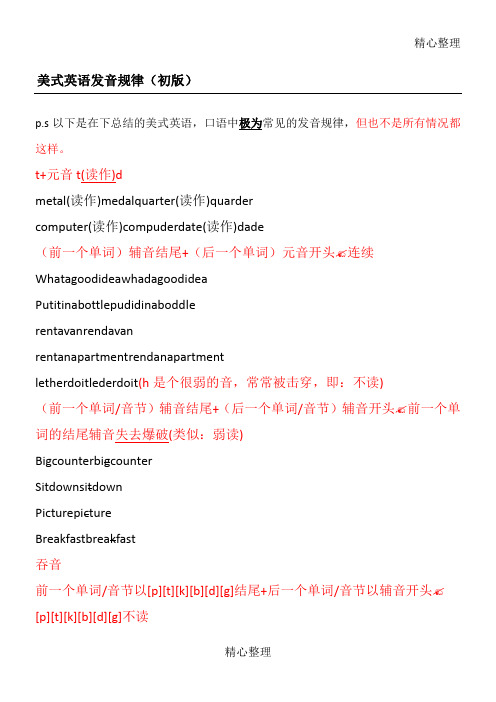
musda=musthave
woulda=wouldhave
`n=andallsheeverwantstoeatisricen’beans
重音(元音拖长,音量放大)(重音不同,表达的意思不同)
词重音
(名词)(动词)
`recordre`cord
`insultin`sult
`co/a:/nductco/e/n`duct
`presentper`sent
`co/a:/ntentco/e/n`tent
(固定词组)(描述性词组)
`blakeboard黑板blake`board黑色的板/甲板
`hotdog热狗hot`dog
`whitehouse白宫white`house白色的房子
Abigchanceabichance
变音
d+j=d?wouldyou
t+j=chaboutyoulastyear
s+j=sh
z+j=?
前一个单词的结尾辅音与后一个单词的开头辅音发音相同叠合
Gooddaygooday
Keeppacekeepace
Busstationbustation
Takecaretacare(因为这里e不发音,k和c的发音都是[k])
常见简音(总结)
dunno=don’tknowIdunno=Idon’tknow
`em=themgav`emtome=gavethemtome
Tak`emtome=takethemtome
Pud`emtome=putthemtome
gimme=giveme
gonna=goingtoheisnotgonnabehome=heisnotgoingtobehome
美语发音规则与技巧_语音法则
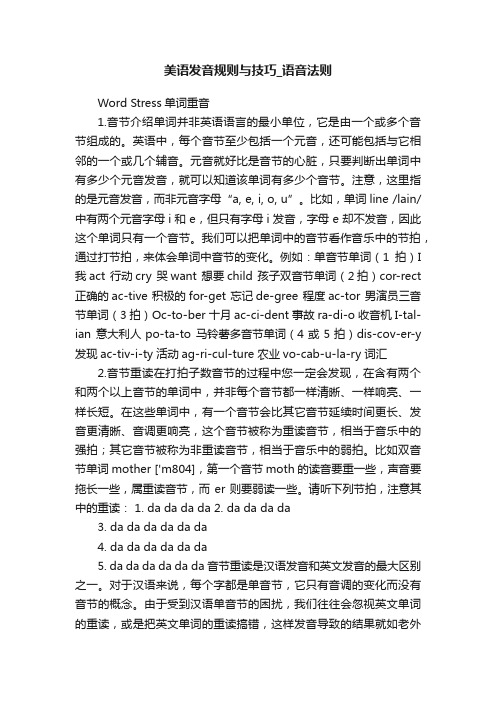
美语发音规则与技巧_语音法则Word Stress单词重音1.音节介绍单词并非英语语言的最小单位,它是由一个或多个音节组成的。
英语中,每个音节至少包括一个元音,还可能包括与它相邻的一个或几个辅音。
元音就好比是音节的心脏,只要判断出单词中有多少个元音发音,就可以知道该单词有多少个音节。
注意,这里指的是元音发音,而非元音字母“a, e, i, o, u”。
比如,单词line /lain/中有两个元音字母i和e,但只有字母i发音,字母e却不发音,因此这个单词只有一个音节。
我们可以把单词中的音节看作音乐中的节拍,通过打节拍,来体会单词中音节的变化。
例如:单音节单词(1拍)I 我act 行动cry 哭want 想要child 孩子双音节单词(2拍)cor-rect 正确的ac-tive 积极的for-get 忘记de-gree 程度ac-tor 男演员三音节单词(3拍)Oc-to-ber 十月ac-ci-dent 事故ra-di-o 收音机I-tal-ian 意大利人po-ta-to 马铃薯多音节单词(4或5拍)dis-cov-er-y 发现ac-tiv-i-ty 活动ag-ri-cul-ture 农业vo-cab-u-la-ry 词汇2.音节重读在打拍子数音节的过程中您一定会发现,在含有两个和两个以上音节的单词中,并非每个音节都一样清晰、一样响亮、一样长短。
在这些单词中,有一个音节会比其它音节延续时间更长、发音更清晰、音调更响亮,这个音节被称为重读音节,相当于音乐中的强拍;其它音节被称为非重读音节,相当于音乐中的弱拍。
比如双音节单词mother ['m804],第一个音节moth的读音要重一些,声音要拖长一些,属重读音节,而er则要弱读一些。
请听下列节拍,注意其中的重读: 1. da da da da 2. da da da da3. da da da da da da4. da da da da da da5. da da da da da da音节重读是汉语发音和英文发音的最大区别之一。
美式英语发音音变技巧总结

Sort of =sorta
Because of =becausa
第17大技巧——被击穿的H音
him ——'im Give him a call.
her ——'er Please call her.
第18大技巧——弱读
规律:æ → ə and Ladies and gentlemen
第2大技巧——r音的连读
For example My friend comes from a country far away . There is 10 minutes left. I'll love you forever.
第3大技巧——辅音连缀
S+m You're smart. S+n His shirt is as white as snow S+l Did you sleep well? S+w No sweet without sweat P+l What’s your plan for the future? G+l I am very glad that you could come. P+r The price of that house is high. S+pr The rumor quickly spread through. S+tr He was a strict father.
Phonetics Changing
语音音变训练
On the Way to ...
奇 同类音消失,缩读, 情态与过去缩读,of 缩读,h击穿,弱读
化 浊化,同化,异化
音变
英语的发音技巧和连读规则 (史上最全最权威)

英语的发音技巧和连读规则A.美语发音的特点1)腹式发音听美音质特别浑厚,听起来共鸣时间很长,甚至带有很浓重的鼻音。
所谓的腹式发音,指的是美式发音讲究的腹腔发声习惯,这和我们汉语遵循的胸腔发声的习惯大大相径庭。
如果想练习最纯正地道的美语,一定要习惯养成腹腔发声的习惯,做到用发音器官的后部发音。
2)字面发音一般单词怎么拼写就怎么发音,发音更具规则性。
比如卷舌音[r]的处理,在美语中只要有字母r,发音的时候就要卷舌;反之,没有字母r,发音就不要卷舌!3)强弱分明在美语中重读和弱读。
美语的节奏是有重读和弱读交替而产生的(the alternation of stressed and unstressed syllables),所以如果我们如果想让自己的话说出来有节奏感,就要重读该重读的音节,弱读该弱读的地方,这就强弱分明的原则。
单词的重音也要注意,我们首先不能随便移动单词的重音,其次要弱读没有重音的音节,最忌把每个音节上,可是我们习惯上会重读第二个音节,这就是习惯的不同,必须纠正。
B.英音发音的特点1、美音的共振焦点(resonance focus),也就是肌肉运动最多的地方,在口腔中后部的舌与腭之间,也就是所谓的“发音靠后”;英音的共振焦点在牙齿前面、嘴唇之间,嘴唇和面部肌肉运动得更多,也就是所谓的“发音靠前”。
2、美音的音调只在音节之间变化,而不在音节之内变化。
音节之内没有音高的滑动(pitch glide);英音则通过音高的滑动来用于强调逻辑上重要的词语。
所谓音高滑动,是指拉长音节并升高音调。
3、有3个主要元音在英音中总是不同。
/o/在美音中是两段式发音,/??/而在英音中前面加上了一个/?/的音,变成了三段式。
英音的/?/短促有力,嘴唇快速滑动,口形变小。
英音的/?:/发音时,双唇要前伸很远,并弯成圆形,只留下很小的开口。
4、有一些音在英音中只是有时不同。
/i:/在单词结尾(尤其是拼写作y或ly)时弱化为/i/,例如pretty、mostly。
最全美语语音规则

单词读音的省略现象
2.略读
01
They have→They’ve; ②They are →They’re
02
He is →He’s ④are not →aren’t
两个或两个以上单词读音的合并现象.
3.缩读
3.最常见缩读词组总结
⑴are you →ya ☆Where ya going? ⑵does she →dushi ☆Dushi speak English? ⑶don’t know →dunno ☆I dunno him. ⑷give me →gimme ☆Gimme that. ⑸going to →gonna ☆I’m gonna help him. ⑹have got to →gotta ☆I gotta help him. ⑺in front of →in fronna ☆He’s in fronna the house. ⑻out of → outta ☆ Get outta here. ⑼want to →wanna ☆ I wanna go home. ⑽what are you →Wachya/ wacha ☆Wachya/ wacha doing ⑾ sort of →sorta ; kind of →kinda
father and son Cheer up!
as far as I do it for~him.
4.r/re+元音型连读
/l/ fall on sleep, all of a sudden
1.辅音与元音之间的连读
以辅音结尾的单词 + h开头的单词h不发音,与前面的辅音连读 Tell~her I miss~her. What wil(l he) [wili]do? Ha(s he) [zi] done~it before? Mus(t he) [ti] go? Can he [ni] do it? Should he [di] ….? Tell him to ask her…. Lea(ve him) [vim].
地道美式英语发音规则及总结
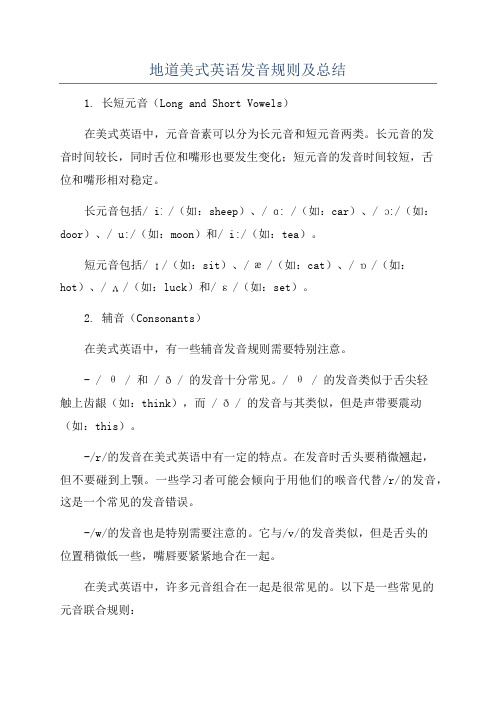
地道美式英语发音规则及总结1. 长短元音(Long and Short Vowels)在美式英语中,元音音素可以分为长元音和短元音两类。
长元音的发音时间较长,同时舌位和嘴形也要发生变化;短元音的发音时间较短,舌位和嘴形相对稳定。
长元音包括/ iː /(如:sheep)、/ ɑ: /(如:car)、/ ɔ:/(如:door)、/ u:/(如:moon)和/ i:/(如:tea)。
短元音包括/ ɪ /(如:sit)、/ æ /(如:cat)、/ ɒ /(如:hot)、/ ʌ /(如:luck)和/ ɛ /(如:set)。
2. 辅音(Consonants)在美式英语中,有一些辅音发音规则需要特别注意。
- / θ / 和/ ð / 的发音十分常见。
/ θ / 的发音类似于舌尖轻触上齿龈(如:think),而/ ð / 的发音与其类似,但是声带要震动(如:this)。
-/r/的发音在美式英语中有一定的特点。
在发音时舌头要稍微翘起,但不要碰到上颚。
一些学习者可能会倾向于用他们的喉音代替/r/的发音,这是一个常见的发音错误。
-/w/的发音也是特别需要注意的。
它与/v/的发音类似,但是舌头的位置稍微低一些,嘴唇要紧紧地合在一起。
在美式英语中,许多元音组合在一起是很常见的。
以下是一些常见的元音联合规则:- /əʊ/(如:go)和/oʊ/(如:boat)在发音上很相像。
发音时嘴巴要比较开,舌位要比较低,并伴有嘴唇嘟音。
- /aɪ/(如:fight)和 /aʊ/(如:house)在发音上也有相似之处。
/aɪ/ 的发音相对较短,舌位较低;而/aʊ/的发音要稍微拉长一点,舌位要稍微抬高一些。
4. 重音和弱音(Stress and Weak Forms)在美式英语中,有一些词汇的重音和弱音是需要特别注意的。
在单词中,重音通常会改变元音的发音。
-重音通常出现在名词、形容词和动词上,弱音通常出现在冠词、连词、介词和助动词上。
美语发音规则与技巧(笔记)
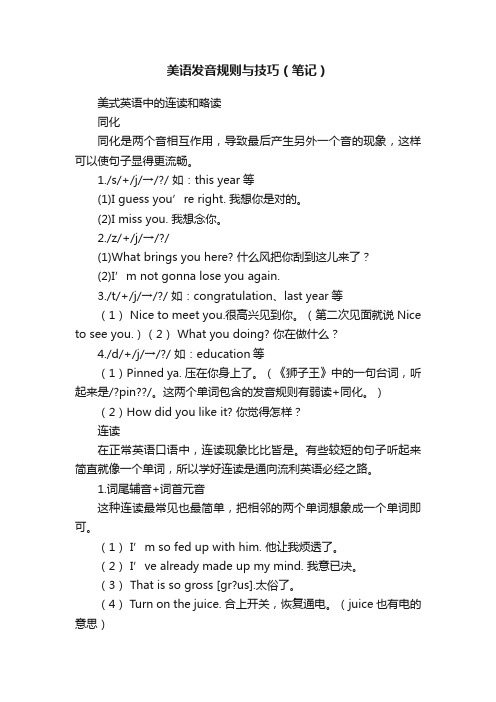
美语发音规则与技巧(笔记)美式英语中的连读和略读同化同化是两个音相互作用,导致最后产生另外一个音的现象,这样可以使句子显得更流畅。
1./s/+/j/→/?/ 如:this year等(1)I guess you’re right. 我想你是对的。
(2)I miss you. 我想念你。
2./z/+/j/→/?/(1)What brings you here? 什么风把你刮到这儿来了?(2)I’m not gonna lose you again.3./t/+/j/→/?/ 如:congratulation、last year等(1) Nice to meet you.很高兴见到你。
(第二次见面就说Nice to see you.)(2) What you doing? 你在做什么?4./d/+/j/→/?/ 如:education等(1)Pinned ya. 压在你身上了。
(《狮子王》中的一句台词,听起来是/?pin??/。
这两个单词包含的发音规则有弱读+同化。
)(2)How did you like it? 你觉得怎样?连读在正常英语口语中,连读现象比比皆是。
有些较短的句子听起来简直就像一个单词,所以学好连读是通向流利英语必经之路。
1.词尾辅音+词首元音这种连读最常见也最简单,把相邻的两个单词想象成一个单词即可。
(1)I’m so fed up with him. 他让我烦透了。
(2)I’ve already made up my mind. 我意已决。
(3) That is so gross [ɡr?us].太俗了。
(4) Turn on the juice. 合上开关,恢复通电。
(juice也有电的意思)2.词尾元音+词首元音A:以/u/、/?/、/au/、/o/结尾的单词与跟在后面的元音连读时,两个元音之间加上一个较轻的/w/,这样过渡就会很自然。
(1) Just do it. 尽管去做吧!(2)It’s snowing. 下雪了。
美式英语口语的发音技巧(最新)
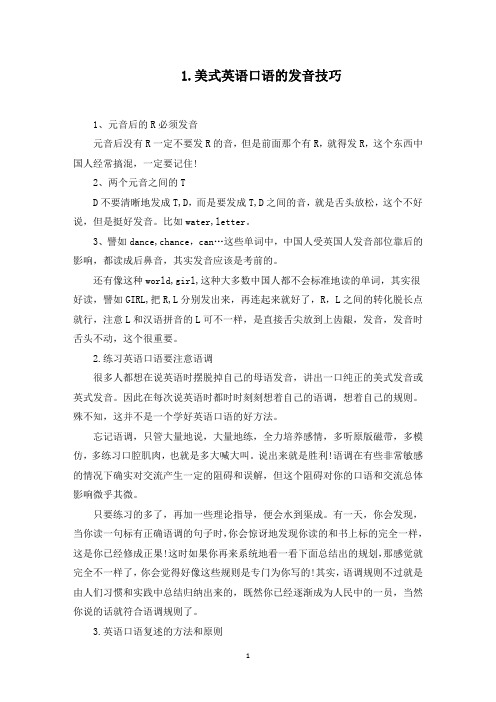
1.美式英语口语的发音技巧1、元音后的R必须发音元音后没有R一定不要发R的音,但是前面那个有R,就得发R,这个东西中国人经常搞混,一定要记住!2、两个元音之间的TD不要清晰地发成T,D,而是要发成T,D之间的音,就是舌头放松,这个不好说,但是挺好发音。
比如water,letter。
3、譬如dance,chance,can…这些单词中,中国人受英国人发音部位靠后的影响,都读成后鼻音,其实发音应该是考前的。
还有像这种world,girl,这种大多数中国人都不会标准地读的单词,其实很好读,譬如GIRL,把R,L分别发出来,再连起来就好了,R,L之间的转化脱长点就行,注意L和汉语拼音的L可不一样,是直接舌尖放到上齿龈,发音,发音时舌头不动,这个很重要。
2.练习英语口语要注意语调很多人都想在说英语时摆脱掉自己的母语发音,讲出一口纯正的美式发音或英式发音。
因此在每次说英语时都时时刻刻想着自己的语调,想着自己的规则。
殊不知,这并不是一个学好英语口语的好方法。
忘记语调,只管大量地说,大量地练,全力培养感情,多听原版磁带,多模仿,多练习口腔肌肉,也就是多大喊大叫。
说出来就是胜利!语调在有些非常敏感的情况下确实对交流产生一定的阻碍和误解,但这个阻碍对你的口语和交流总体影响微乎其微。
只要练习的多了,再加一些理论指导,便会水到渠成。
有一天,你会发现,当你读一句标有正确语调的句子时,你会惊讶地发现你读的和书上标的完全一样,这是你已经修成正果!这时如果你再来系统地看一看下面总结出的规划,那感觉就完全不一样了,你会觉得好像这些规则是专门为你写的!其实,语调规则不过就是由人们习惯和实践中总结归纳出来的,既然你已经逐渐成为人民中的一员,当然你说的话就符合语调规则了。
3.英语口语复述的方法和原则学英语离不开记忆,记忆不是死记硬背,要有灵活性。
复述就是一种很好的自我训练口语,记忆单词、的句子的形式。
复述有两种常见的方法。
一是阅读后复述,一是听磁带后复述。
- 1、下载文档前请自行甄别文档内容的完整性,平台不提供额外的编辑、内容补充、找答案等附加服务。
- 2、"仅部分预览"的文档,不可在线预览部分如存在完整性等问题,可反馈申请退款(可完整预览的文档不适用该条件!)。
- 3、如文档侵犯您的权益,请联系客服反馈,我们会尽快为您处理(人工客服工作时间:9:00-18:30)。
1. 击穿连读(1) /h/很弱,很容易被击穿with+him=with(h)imwith+her=with(h)er(2) /t/和/d/在/n/后通常被击穿twenty--twen(t)yinternet--in(t)ernetwanted--wan(t)edand+l=an(d) I(3) /th/ 在/n/后有时也被击穿seen+that=seen (th)atrve never seen that movie.(4) with 后如果有弱读的元音音节,with有时会变成/wit/with+our=wit(h)arwith+it=wit(h)Di2. 失去爆破爆破音(t d k g p b) 后接除了/j/, /w/, /r/ 之外的辅音要失去爆破*遇到/h/可算到击穿连读的情况里3. 融合t+j=chNice to meet you.d+j=d3I called you yesterday.s+j=shGod bless you.z+j=3ril do as you wish.4•闷音garden, student, sentence5.浊化(1) t的浊化Italy, later, betterItalian, hotel(2) s后爆破轻辅音的浊化sky, star, speak一、连读的条件:相邻的两词在意义上必须密切相关,同属一个意群。
连读所构成的音节一般都不重读,只需顺其自然地一带而过,不可读得太重,也不可音。
(连读符号:~)二、连读规则1. 辅音+元音"型连读在同一个意群里,如果相邻两词中的前一个词是以辅音结尾,后一个词是以元音开头,这就要将辅音与元音拼起来连读。
I m~an~English boy.It~is~a n~ old book.Let me have~a look~at~it.Ms Black worked in~an~office last~yesterday.I called~you half~a n~hour~ago.Put~it~ on, please.Not~at~all.Please pick~it~up.2. f/re+元音”型连读如果前一个词是以-r或者-re结尾,后一个词是以元音开头,这时的r或re不但要发/r/ 的元音拼起来连读。
They 're my father~and mother.I looked for~it here~a nd there.There~is a football un der~it.There~are some books on the desk.Here~is a letter for you.Here~are four~eggs.But where~is my cup?Where~are your brother~a nd sister?但是,如果一个音节的前后都有字母r,即使后面的词以元音开头,也不能连读。
The black clouds are coming nearer and nearer. (nearer 与and 不可连读)there 与is 连读为theris [ e?? ris] there 与are 连读为therare[ e?? ra]3. 辅音+半元音"型连读英语语音中的/j/和/w/是半兀音,如果前一个词是以辅音结尾,后一个词是以半兀音,特别是时也要连读。
Thank~you.Nice to meet~you.Did~you get there late~aga in?Would~you like~a cup~of tea ?Could~you help me, please?辅音+半元音"型连读英语语音中的/j/和/w/是半兀音,如果前一个词是以辅音结尾,后一个词是以半兀音,特别是/j/读。
Thank~you. ,而且还要与后面/j/开头,此开头,此时也要连Nice to meet~you.Did~you get there late~aga in?Would~you like~a cup~of tea ?Could~you help me, please?注意:一常把/d/+/j/ 读成/d ?/ , did you 听上成了/did ?u/ , would you 成了/wud?u/, could you 成了/kud ?u/。
音的同化也是一种连读的现象,两个词之间非常平滑的过渡,导致一个音受临音影响而变化。
主要是以下三种方式:1、辅音[d]与[j]相邻时,被同化为[d ?]: Would you....?2、辅音[t]与[j]相邻时,被同化为[t J]: Can' you: 。
?3、辅音[s]与[j]相邻时,被同化为[J: Miss you4.兀曰+兀曰”型连读如果前一个词以兀音结尾,后一个词以兀音开头,这两个音往往也要自然而不间断地连读到一起。
I~am Chin ese.He~is very frien dly to me.She wants to study~E nglish.How~a nd why did you come here?She can 'carry~it.It 'ltake you three~hours to walk there.The questi on is too~easy for him to an swer.(4)元音+元音”型元音对元音的连续实际上是在元音之间插入半元音[j]或[w],从而使纯元音音节之间的过渡变得自然、流畅,读起来更加上口。
半元音插入情况如下:前面的单词以敞口元音[i][e]结尾,紧随其后的单词以元音[i]、[e]、⑻]、[?i]、[i]开头,这时,在两个单词之间出现半元音[j]作为过渡。
前面的单词以闭口元音[u]、[?u]结尾,紧随其后的单词以元音[u]、[?u]、[au]开头,这时,在两个单词之间出现半元音[w]作为过渡。
radio How are you doing?[e][ai][oi]举例[?u] w [ ?]连读go w aut hou w old 为了把两个相邻的词连在一起,人们往往在以[?][a]音节结尾的单词后面加上[r]音,以便和后一个词的其首元音连接,这种添加的[r]称为外加音”[r]。
i~am Chin ese.He~is very frien dly to me.She wants to study~E nglish.How~a nd why did you come here?She can 'tcarry~it.It 'take you three~hours to walk there.The questi on is too~easy for him to an swer.5.失去爆破。
6个爆破音有3对/p/ , /b/,用,/d/ , /k/ , /g/失去爆破,又叫不完全爆破,就是在某些情况下,只须做出发音的准备,但并不发音,稍稍停顿后就发后面的音。
(1) 爆破音+爆破音”型6个爆破音中的任意2个相临时,前一个爆破音会失去爆破,即由相关的发音器官做好这个发音的姿势,稍做停顿后即发后面的爆破音。
The girl in the re(d) coat was on a bla(ck) bike jus(t) now.The bi(g) bus from the fa(c) tory is full of people.Wha(t) time does he get up every morningThis is an ol(d) pi(c)ture of a bi(g) car.The ol(d) do(c)tor has a ca(t), too.W&e going to work on a farm n ex(t) Tuesday.What would you like, ho(t) tea or bla(ck) coffee?It 'a very col(d) day, but it 'a goo(d) day.You can put i(t) dow n in the bi(g) garde n.I bought a chea(p) book, but it 's a goo(d) book.bla (ck) board, foo (t) ball, ke (p) t(2) 爆破音+摩擦音”型如果前面是爆破音,其后紧跟着某些摩擦音(如/f/ ,/s/,/W/,/T/等),那么前面那个爆破音仅有十分轻微的爆破,而后面那个摩擦音则要完全爆破。
Goo(d) morning, Mr. Bell.Goo(d) morning, dear.Uncle Li 's fa(c)tory is qui(te) n ear to the cin ema.I wen (t) there alone a(t) nine las(t) ni ght.-Do you know his bi(ke) nu mber? -Sorry, I don (t) know.The forty-firs(t) less on is qui(te) difficult.I did n'(t) say so不完全爆破在两个相邻单词之间出现的情况非常多。
① 爆破音中的任何两个爆破音相邻时,前一爆破音失去爆破。
女口a bi(g) car等。
② 爆破音中的任何一个后接摩擦音/f/ , /s/时,前面的爆破音失去爆破。
如I didn\'(t) say so. ③爆破音后接/t/ , /d/ , /tr/ , /dr / 时,前面的爆破音失去爆破。
如 a grea(t) change 等。
④爆破音后接/m/, /n/ , /l/ 时,前面的爆破音失去爆破。
如 a bi(t) more expensive 等。
当短语或从句之间按意群进行停顿时,意群与意群之间即使有两个相邻的辅音与元音出现,也不可连读。
Is~it a~hat or a cat? (hat与or之间不可以连读)There~is~a good book in my desk. (book 与in 之间不可以连读)Can you speak~English or French? (English 与or 之间不可以连读)Shall we meet at~eight or ten tomorrow morning? (meet 与at , eight 与or 之间不可以连读)She opened the door and walked~in. (door 与and 之间不可以连读)一、连读连读有两种规则,分别为:1、以辅音结尾的单词+元音开头的单词:要连读如: I ' li(ke a)nother bow(l o)f rice.这里like / laik / 以辅音结尾,another 以元音开头,所以连读以辅音结尾指的是音标中的最后一个音是辅音,而不是单词的结尾,这如同u[ju:.]niversity 前面的定冠词必须用a 一样。
